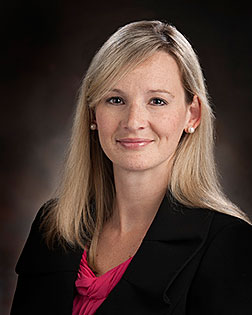- Number 431 |
- January 26, 2015
Dr. Lindsay Sexton, Senior Scientist, Nonproliferation Policy Support, Savannah River National Laboratory

Dr. Lindsay Sexton
When Senior Scientist Lindsay Sexton of DOE's Savannah River National Laboratory first left for college, the plan was to study medicine. But after a few biology classes, the pre-med student realized she needed a new calling. Then her chemistry professor had one simple request — she was asked to help with research investigating the effects of metal overlayers on self-assembled monolayers. It was at that time that Sexton realized she had a future in research and development.
“I really liked the problem solving aspect of research and the freedom to explore new ideas in the laboratory,” said Sexton, who works in Nonproliferation Policy Support at SRNL. “The professor I worked for encouraged me to go to graduate school for chemistry and pursue a PhD. I ended up at the University of Florida where I worked on the development of protein sensors using single nanopore membranes.”
Sexton said she never imagined working in the field of National Security Studies. “After graduate school I was looking for a job and I came across a booth for the Savannah River National Laboratory at a career fair. I was eventually offered a post-doctoral position at SRNL sponsored by NNSA's Next Generation Safeguards Initiative (NGSI). The NGSI program really got me interested in nuclear safeguards and nonproliferation. I really never set out with a goal to work as a scientist in research and development, but I followed my interest in science and took opportunities that were presented to me along the way.”
Sexton’s work and that of her research team has led to remarkable advances in nonproliferation technologies and nuclear safeguards. Her first project as a post-doctoral researcher at SRNL was the development of a nano proportional counter. The device uses a nano-scale array as the anode in a gas-filled proportional counter to detect radiation at lower operating voltages than conventional designs. Sexton and the research team are currently seeking a patent for that technology, as well as a patent for a method to fabricate photonic crystals to help increase light output from scintillators.
It’s Sexton’s work in nuclear safeguards that is setting her apart from others. In 2010 she started working on two safeguards projects that still continue. The first was to develop the tamper resistant indicating aerosol contaminant extractor (TRI-ACE). The TRI-ACE is an automated aerosol particle collector that can be used to collect airborne particulates of importance to nuclear safeguards and nonproliferation. The TRI-ACE prototype was completed in 2013 and field tested in an operational facility. The results of the field trial were recently reported at a safeguards symposium at the International Atomic Energy Agency in Vienna.
The other safeguards project is the development of a test bed at the Savannah River Site’s H Canyon. The goal of this project is to establish H Canyon as a location where researchers can test and demonstrate novel safeguards technologies in an operational environment. “Testing new technologies in a realistic environment is an important step in the development process. With H Canyon being the only operational full-scale nuclear separations facility in the U.S. it serves as an ideal location for such testing,” said Sexton.
Also among her accomplishments, Sexton has been awarded two coveted Laboratory Directed Research and Development grants. “My first LDRD explored the use of nanomaterials for separation and sequestration of long-lived actinides from waste streams. I am currently leading an LDRD that is looking at technologies that could be used for in-line process monitoring at nuclear facilities.”
Sexton says she enjoys working with others in a multi-disciplinary team environment. “I believe that a team with the right individuals can accomplish so much more than any one person alone.” She says she also wants to encourage young people to become involved in science. “I've been part of chemistry demonstrations and talks at several local schools and community events. I really enjoy working with younger kids and seeing them get excited about chemistry experiments.”
Sexton’s work has been published in a multitude of publications. She is a member of the American Chemical Society (ACS) and the Institute of Nuclear Materials Management (INMM). She also recently served as Chairman of the local ACS section and is the current Immediate Past Chair. Sexton is also starting her second year as the Secretary for the Southeast Chapter of INMM.Submitted by DOE's Savannah River National Laboratory
